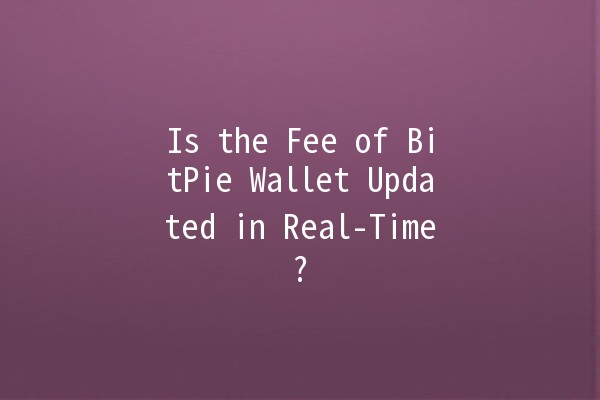




In the rapidly evolving world of cryptocurrency, the choice of wallet can significantly influence user experience, transaction speed, and costs incurred during trading and transaction activities. Among the myriad of wallets available, BitPie Wallet stands out due to its userfriendliness and comprehensive features. However, one common question among users is: Is the fee of BitPie Wallet updated in realtime? This article aims to delve into this question, explore factors that affect transaction fees, and provide actionable insights to optimize your experience with BitPie Wallet.
Before we address whether BitPie Wallet fees are updated in realtime, it’s crucial to understand what transaction fees are and how they work. Fees are essentially payments made to miners or validators in the network for processing transactions. These fees can vary based on several factors:

BitPie Wallet adopts a flexible fee structure influenced by the factors mentioned above. While the exact fee applied can vary, users typically have some degree of control over how much they wish to pay. Here's how it works:
Dynamic Fees: BitPie Wallet tends to adjust fees dynamically based on network conditions. In times of high traffic, fees may rise, and during quieter periods, fees may decrease.
User Control: Users often have the option to set their fees manually, allowing for more strategic decisionmaking when it comes to transaction speed versus cost.
The answer is nuanced. Yes, BitPie Wallet does allow for realtime updates of transaction fees, influenced predominantly by network conditions. Here's a deeper look into how the realtime update mechanism operates:
This realtime fee update system can save users both time and money by providing awareness of optimal transaction timings.
Navigating transaction fees efficiently can significantly enhance your trading experience. Here are five actionable tips to manage and minimize fees effectively on BitPie Wallet:
Description: Stay informed about the current state of the blockchain network you are trading on.
Application: Use sites like Blockchain.info to review current network congestion trends. Timing your transactions during lower traffic periods can lead to cost savings on fees.
Description: Avoid executing transactions during peak hours when fees are likely to be inflated.
Application: If possible, wait until network traffic reduces, potentially saving a significant amount on fees. Analyze historical data to identify these trends.
Description: Utilize builtin tools within BitPie Wallet to gauge and select appropriate transaction fees.
Application: Before making a transaction, check the suggested fee based on the current network state and adjust it according to your needs.
Description: If you are familiar with blockchain operations, manually setting transaction fees can provide significant flexibility.
Application: In cases where the default suggested fee seems too high, manually adjust it down as long as you are okay with potential delays in transaction processing.
Description: Understand the different fees associated with various types of transactions (e.g., sending, swapping, etc.)
Application: For highvalue transactions, consider if a higher fee is justified by the need for speed. Conversely, for lowervalue transactions, you might prefer to postpone until fees are more favorable.
The transaction fees on BitPie Wallet are calculated based on the network’s current demand for space in the blockchain. When network demand is high, fees increase, while they drop when demand decreases.
Yes, users can set custom transaction fees in the BitPie Wallet app, allowing for a tradeoff between transaction speed and cost.
If a transaction fee is set too low, there’s a risk that the transaction will not be picked up by miners promptly, leading to delays in processing. In extreme cases, it may not be processed at all.
Yes, BitPie Wallet often sends notifications regarding fee changes, allowing users to be informed before completing a transaction.
No, users generally do not incur any maintenance fees for keeping their funds in BitPie Wallet, but standard transaction fees apply when moving funds.
Yes, users can usually view detailed transaction information, including fees, in their transaction history within the BitPie Wallet app.
In the complex ecosystem of cryptocurrency, understanding transaction fees is paramount for any user engaging with digital wallets like BitPie. With its realtime fee updates, transparency, and usercontrolled fee settings, BitPie Wallet provides an effective platform for managing costs while ensuring secure transactions. By utilizing the strategies discussed, users can optimize their experience, save on fees, and make informed decisions about their digital assets.
By staying informed and proactive, users can navigate the world of cryptocurrency with confidence, making the most of their BitPie Wallet experience. Make sure to explore all features available and take advantage of the dynamic fee structures to become a savvy cryptocurrency user!